Range 12,670 km Length 61 m Cruise speed 876 km/h | Wingspan 52 m Top speed 945 km/h | |
 | ||
Unit cost 150,000,000–200,000,000 USD (2013) Engine types Pratt & Whitney PW4000, General Electric CF6 | ||
Douglas dc 10 vs mcdonnell douglas md 11 vs lockheed tristar l1011
The McDonnell Douglas MD-11 is an American three-engine medium- to long-range wide-body jet airliner, manufactured by McDonnell Douglas and, later, by Boeing Commercial Airplanes. Based on the DC-10, it features a stretched fuselage, increased wingspan with winglets, refined airfoils on the wing and smaller tailplane, new engines and increased use of composite materials. Two of its engines are mounted on underwing pylons and a third engine at the base of the vertical stabilizer. It also features a glass cockpit that decreases the flight deck crew from the three required on the DC-10 to two by eliminating the need for a flight engineer.
Contents
- Douglas dc 10 vs mcdonnell douglas md 11 vs lockheed tristar l1011
- Fedex mcdonnell douglas md 11 vs ups boeing 747 back to back cargo planes aviation in india
- Origins
- Launch and production
- Design
- Variants
- Undeveloped variants
- Operators
- Accidents and incidents
- Notable accidents and incidents
- Safety problems
- Specifications
- References
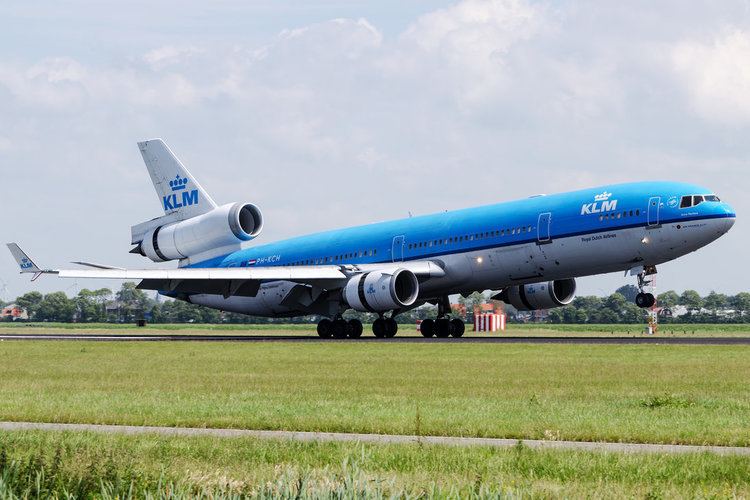
Fedex mcdonnell douglas md 11 vs ups boeing 747 back to back cargo planes aviation in india
Origins
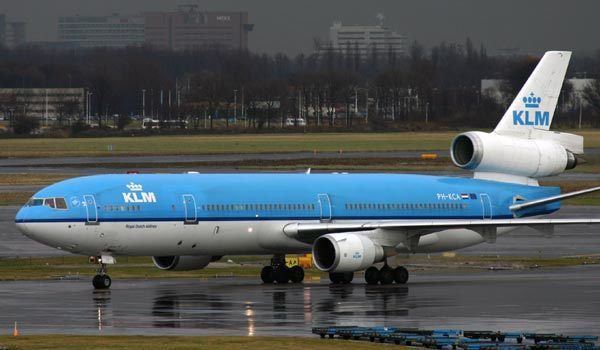
Although the MD-11 program was launched in 1986, McDonnell Douglas started to search for a DC-10 derivative as early as 1976. Two versions were considered then, a DC-10-10 with a fuselage stretch of 40 feet (12 m) and a DC-10-30 stretched by 30 feet (9.1 m). That later version would have been capable of transporting up to 340 passengers in a multi-class configuration, or 277 passengers and their luggage over 5,300 nautical miles (9,800 km). At the same time, the manufacturer was seeking to reduce wing and engine drag on the trijet. Another version of the aircraft was also envisaged, the "DC-10 global", aimed to counter the risks of loss of orders for the DC-10-30 that the Boeing 747SP and its range were creating. The DC-10 global would have incorporated more fuel tanks.
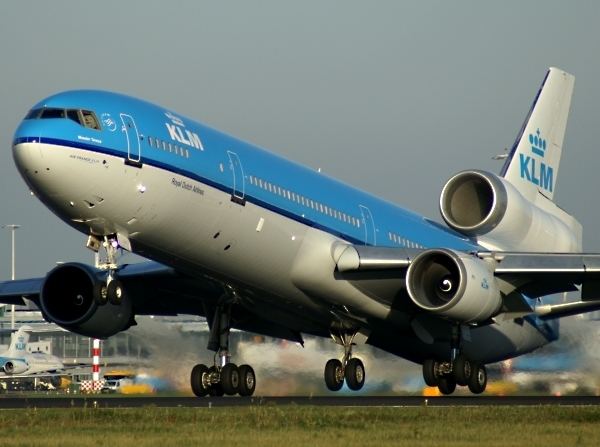
While continuing their research for a new aircraft, McDonnell Douglas designated the program DC-10 Super 60, previously known for a short time as DC-10 Super 50. The Super 60 was to be an intercontinental aircraft incorporating many aerodynamic improvements in the wings, and a fuselage lengthened by 26 feet 8 inches (8.13 m) to allow for up to 350 passengers to be seated in a mixed-class layout, compared to 275 in the same configuration of the DC-10.
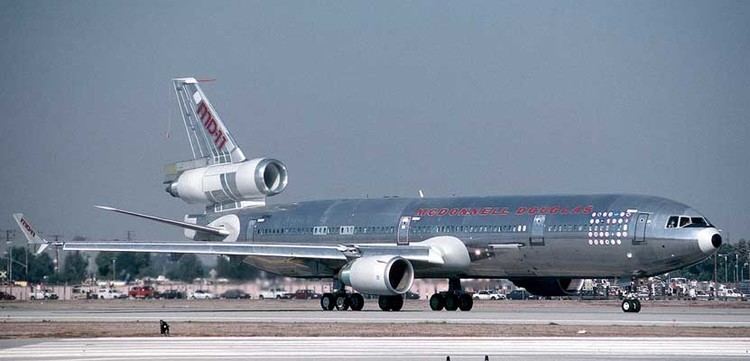
Following more refinements, in 1979 the DC-10 Super 60 was proposed in three distinct versions like the DC-8. The DC-10-61 was designed to be a high-capacity medium-range aircraft. It would have a fuselage stretch of 40 feet (12 m) over the earlier DC-10 models, enabling it to carry 390 passengers in a mixed class or 550 passengers in an all-economy layout, similar to Boeing's later 777-300 and Airbus A340-600. Like for the DC-8, the series 62 was proposed for long-range routes. It would feature a more modest fuselage stretch of 26 ft 7 in (8.10 m), along with an increased wingspan and fuel capacity. It would be capable of carrying up to 350 passengers (mixed class) or 440 passengers (all-economy), similar to the later Boeing 777-200 or the Airbus A330-300/A340-300/500. Finally, the series 63 would have incorporated the same fuselage as the DC-10-61 as well as all the larger wing of the -62. After high-profile accidents in the 1970s, such as Turkish Airlines Flight 981 and American Airlines Flight 191, the trijet's reputation was seriously damaged by doubts regarding its structural integrity. For these reasons, and due to a downturn in the airline industry, all work on the Super 60 was stopped.
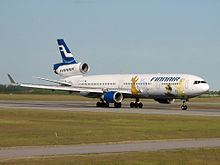
In 1981, a Continental DC-10-10 (registration number N68048) was leased to conduct more research, particularly the effects the newly designed winglets would have on aircraft performance. Different types of winglets were tested during that time in conjunction with NASA. McDonnell Douglas was again planning new DC-10 versions that could incorporate winglets and more efficient engines developed at the time by Pratt & Whitney (PW2037) and Rolls-Royce (RB.211-535F4). The manufacturer finally rationalized all these studies under the MD-EEE (Ecology-Economy-Efficiency) designation, that was later modified to the MD-100 following some more changes. The MD-100 was proposed in two versions: the Series 10, having an airframe shorter by 6 ft 6 in (1.98 m) compared to the DC-10 and seating up to 270 passengers in a mixed-class configuration; and the Series 20, incorporating a fuselage stretch of 20 ft 6 in (6.25 m) over the DC-10 and able to seat up to 333 passengers in the same kind of configuration as the Series 10. Both versions could be powered by the same engine families as the actual MD-11 plus the RB.211-600. However, the situation for the manufacturer, and the airline industry in general, did not look bright. No new DC-10 orders were received, and many among the observers and customers doubted that the manufacturer would be operating much longer. Thus, the Board of Directors decided in November 1983 to once again cease all work on the projected new trijet.
The following year no new orders for the DC-10 were received. The production line was kept active thanks to earlier orders from the United States Air Force for 60 KC-10A tankers. McDonnell Douglas was still convinced that a new derivative for the DC-10 was needed, as shown by the second-hand market for their Series 30 and the heavier DC-10-30ER version. Thus, in 1984 a new derivative aircraft version of the DC-10 was designated MD-11. From the very beginning, the MD-11X was conceived in two different versions. The MD-11X-10, based on a DC-10-30 airframe, offered a range of 6,500 nautical miles (12,000 km) with passengers. That first version would have had a maximum takeoff weight (MTOW) of 580,000 pounds (260,000 kg) and would have used CF6-80C2 or PW4000 engines. The MD-11X-20 was to have a longer fuselage, accommodating up to 331 passengers in a mixed-class layout, and a range of 6,000 nautical miles (11,000 km).
As more orders for the DC-10 were received, McDonnell Douglas used the time gained before the end of DC-10 production to consult with potential customers and to refine the proposed new trijet. In July 1985, the Board of Directors authorized the Long Beach plant to offer the MD-11 to potential customers. At the time, the aircraft was still proposed in two versions, both with the same fuselage length, a stretch of 22 ft 3 in (6.78 m) over the DC-10 airframe, as well as the same engine choice as the MD-11X. One version would have a range of 4,780 nautical miles (8,850 km) with a gross weight of 500,000 pounds (230,000 kg) and transport up to 337 passengers, while the second would carry 331 passengers over 6,900 nautical miles (12,800 km). A year later, as several airlines had committed to the MD-11, the situation was looking optimistic. The aircraft was now a 320-seater baseline and defined as an 18 ft 7 in (5.66 m) stretch over the DC-10-30 powered by the new advanced turbofans offered by the major engine manufacturers and giving it a range of 6,800 nautical miles (12,600 km). Other versions, such as a shortened ER with a range of 7,500 nautical miles (13,900 km), an all-cargo offering a maximum payload of 200,970 pounds (91,160 kg) and a Combi with a provision for ten freight pallets on the main deck, were proposed. Further growth of the aircraft was also foreseen, such as the MD-11 Advanced.
The lack of innovation from McDonnell Douglas during the MD-11's design had been attributed to the company's declining cash flow, as it struggled with problems with its military contracts and declining orders for its commercial jets. Limited company resources resulting in the MD-11 being developed as a refinement of the existing DC-10, in contrast to rivals Airbus and Boeing who during this time period developed all-new aircraft designs that would become the Airbus A330/A340 and Boeing 777. As a trijet the MD-11 was less fuel-efficient but had a greater range than its mid-size widebody contemporaries which were twinjets, the existing Boeing 767 and upcoming Airbus A330. Aerospace consultant Scott Hamilton, in a 2014 article, said that the MD-11 was "classically ill-timed" as "it came at the end of the three- or four-engine era, just ahead of the real move to ETOPS with the 777".
Launch and production
On December 30, 1986, McDonnell Douglas launched the MD-11 with commitments for 52 firm orders and 40 options in three different versions (passenger, combi and freighter) from ten airlines (Alitalia, British Caledonian, Dragonair, FedEx Express, Finnair, Korean Air, Scandinavian Airlines System, Swissair, Thai Airways International, and VARIG) and two leasing companies (Guinness Peat Aviation and Mitsui). Orders from Dragonair, Scandinavian and UTA, an undisclosed customer, were canceled by 1988.
Assembly of the first MD-11 began on March 9, 1988, and the mating of the fuselage with wings occurred in October that year. The first flight was originally planned to occur in March 1989, but numerous problems with the manufacturing, delays with suppliers producing essential components and labor industrial actions delayed the ceremonial roll out of the prototype until September of that year. The following months were used to prepare the prototype for its maiden flight, which finally happened on January 10, 1990. The first two aircraft manufactured were intended for FedEx and thus, were already fitted with the forward side cargo door. They remained with the manufacturer as test aircraft until 1991 before being completely converted to freighters and delivered to their customer. FAA certification was achieved on November 8, 1990 while the European Joint Aviation Authorities (JAA) certified the MD-11 on October 17, 1991 after approximately 200 separate issues were resolved. Fuselage sections for the DC-10, KC-10, and MD-11 were built by General Dynamics' Convair Division. Yugoslav Airlines, already flying several DC-10s, became the first customer of the MD-11. Three aircraft were manufactured but were never delivered due to war in Yugoslavia. The first MD-11 was delivered to Finnair on December 7, 1990 and it accomplished the first revenue service by an MD-11 on December 20, 1990, carrying passengers from Helsinki to Tenerife in the Canary Islands. MD-11 service in the U.S. was inaugurated by Delta Air Lines, also in 1990.
It was during this period that flaws in the MD-11's performance became apparent. It failed to meet its targets for range and fuel burn. American Airlines in particular was unimpressed with the 19 MD-11s that it received, as was Singapore Airlines who canceled their order for 20 MD-11s and instead ordered ordered 20 Airbus A340-300s. American Airlines cited problems with the performance of the airframe and the Pratt & Whitney PW4000 engines, while Singapore Airlines stated that the MD-11 could not operate on the airline's long haul routes. Pre-flight estimates indicated that the P&W-powered MD-11 was to have a 7,000 nautical miles (13,000 km) range with 61,000 pounds (28,000 kg) of payload. With the Phase 1 drag reduction in place then, the aircraft could only achieve its full range with 48,500 pounds (22,000 kg) of payload, or a reduced range of 6,493 nautical miles (12,025 km) with a full payload.
In 1990, McDonnell Douglas, along with Pratt & Whitney and General Electric began a modification program known as the Performance Improvement Program (PIP) to improve the aircraft's weight, fuel capacity, engine performance and aerodynamics. McDonnell Douglas worked with NASA's Langley Research Center to study aerodynamic improvements. The PIP lasted until 1995 and recovered the range for the aircraft. However, by this point sales of the MD-11 had already been significantly impacted. In 1995, American Airlines sold their 19 MD-11s to FedEx, as the PIP program was not sufficient for the aircraft to fly the Dallas-Hong Kong route.
After McDonnell Douglas merged with Boeing in 1997 the new company decided that MD-11 production would continue, though only for the freighter variant. In 1998, Boeing announced they would end MD-11 production after filling orders on hand. The last passenger MD-11 built was delivered to Sabena in April 1998. Assembly of the last two MD-11s were completed in August and October 2000; they were delivered to Lufthansa Cargo on February 22 and January 25, 2001 respectively. Production ended because of lack of sales, resulting from internal competition from the Boeing 767-400 and Boeing 777, as well as external competition from the Airbus A330/A340.
McDonnell Douglas and later Boeing performed studies on the feasibility of removing the tail engine to make a twin-engine jet, but nothing came of it. McDonnell Douglas originally projected that they would sell more than 300 MD-11 aircraft, but only 200 were built. The MD-11 was assembled at McDonnell Douglas's Douglas Products Division in Long Beach, California (later Boeing's facility).
Design
The MD-11 is a medium- to long-range widebody airliner, with two engines mounted on underwing pylons and a third engine at the base of the vertical stabilizer. It is based on the DC-10, but features a stretched fuselage, increased wingspan with winglets, refined airfoils on the wing and tailplane, new engines and increased use of composites. The winglets are credited with improving fuel efficiency by about 2.5%. The MD-11 has a smaller empennage than the DC-10 it is based upon.
The MD-11 features a two-crew cockpit that incorporates six interchangeable CRT-units and advanced Honeywell VIA 2000 computers. The cockpit design is called Advanced Common Flightdeck (ACF) and is shared with the Boeing 717. Flight deck features include an Electronic Instrument System, a dual Flight Management System, a Central Fault Display System, and Global Positioning System. Category IIIb automatic landing capability for bad-weather operations and Future Air Navigation Systems are available.
The MD-11 was one of the first commercial designs to employ a computer-assisted pitch stability augmentation system that featured a fuel ballast tank in the tailplane, and a partly computer-driven horizontal stabilizer. Updates to the software package made the airplane's handling characteristics in manual flight similar to those of the DC-10, despite a smaller tailplane to reduce drag and increase fuel efficiency.
The MD-11 incorporates hydraulic fuses not included in the initial DC-10 design, to prevent catastrophic loss of control in event of hydraulic failure.
Variants
The MD-11 was manufactured in five variants.
Note: Some or all the features of the MD-11ER, including the higher MTOW of 630,500 lb (286,000 kg), part or all of the PIPs aerodynamic improvements packages and composite panels were fitted to later built MD-11s (except the extra fuel tank), and could be retrofitted to any of the variants, except for the PIP Phase IIIB larger aft engine intake. Some airlines, such as Finnair, Martinair and FedEx have made the structural changes required to allow their aircraft to have the higher MTOW. Swissair's 16 newly delivered aircraft were retrofitted with all the features except for the extra fuel tank and were so-designated MD-11AH for Advanced Heavy.
Undeveloped variants
After ending the MD-12 program, McDonnell Douglas focused on 300-400–seat MD-11 derivatives. At the 1996 Farnborough International Air Show, the company presented plans for a new trijet with high-seating and long-range named "MD-XX". It was offered in the MD-XX Stretch and MD-XX LR versions. The MD-XX Stretch version was to have a longer fuselage than the MD-11 and seat 375 in a typical three-class arrangement. The MD-XX LR was to have a longer range and be the same length as the MD-11; it was to have typical three-class seating for 309. However, the MDC board of directors decided to end the MD-XX program in October 1996, because the financial investment was too large for the company.
Operators
As of July 2016, the worldwide fleet of MD-11s totals 123 aircraft in commercial service with cargo operators FedEx Express (57), UPS Airlines (37), Lufthansa Cargo (12), Western Global Airlines (6), Sky Lease Cargo (4), and other operators with fewer aircraft.
Most of the airlines who ordered the MD-11 for their long-haul passenger flights had replaced it with Airbus A330, A340 and Boeing 777 aircraft by the end of 2004. Some carriers converted their MD-11s to freighters such as China Eastern Airlines and Korean Air. Korean Air announced as early as December 1994 its intention to convert its five-passenger MD-11s to freighters for medium-range cargo routes. In 1995, American Airlines agreed to sell its 19 aircraft to FedEx, with the first MD-11 being transferred in 1996. Japan Airlines (JAL) announced the replacement of its 10 MD-11s in 2000; these aircraft were being converted into freighters and sold to UPS.
In February 2007, TAM Linhas Aéreas began operating the first of three leased passenger MD-11s, in a deal arranged by Boeing as an interim solution for TAM to quickly be able to operate newly granted intercontinental routes while waiting for four Boeing 777-300ERs to be delivered from late 2008. The last MD-11 was retired from TAM's fleet in July 2009, which ended its use by Brazilian airlines (Varig, VASP, and TAM).
In May 2007, Finnair announced the sale of their last two MD-11s to Aeroflot-Cargo to become part of the Russian airline cargo fleet in 2008 and 2009. KLM was the last airline to operate scheduled passenger flights with the passenger version of the MD-11. The final scheduled flight took place on October 26, 2014 from Montréal to Amsterdam, followed by three special roundtrip flights on November 11, 2014.
Two MD-11s were also operated in a VIP configuration, one by Saudia Royal Flight for members of the Royal family, and one by Mid East Jet for ASACO Aviation, both are now stored.
Accidents and incidents
As of September 2015, the MD-11 has been involved in 26 incidents, including nine hull-loss accidents, with 240 fatalities.
Notable accidents and incidents
Safety problems
The MD-11 has had problems with its flight control systems that have resulted in multiple accidents and incidents since the aircraft's introduction. The initial design of the slat/flap lever in the cockpit was conducive to accidental dislodgement by crew in flight. The defect has been corrected since 1992. In the early 2000s, Boeing improved the flight control software at the urging of the FAA to reduce the possibility of violent unintentional pitch movements.
In an effort to improve fuel efficiency, McDonnell Douglas designed the MD-11's center of gravity to be much further aft than other commercial aircraft. There was also a fuel-ballast tank in the MD-11's horizontal stabilizer since its tailplane was smaller than the DC-10's to improve fuel efficiency, but this was found to inhibit the MD-11's crosswind performance. These design features significantly reduced the MD-11's margin for error during the takeoff and landing phases, making it more difficult to handle than the smaller DC-10. A number of operators have introduced special training to assist crews in safely handling the MD-11's critical phases of flight.
Specifications
Notes: *Heavy refers to aircraft with "Extended Range" option and aircraft with ER option without additional fuel tank. ER option available on all models. Standard refers to basic original configuration.
Sources:
